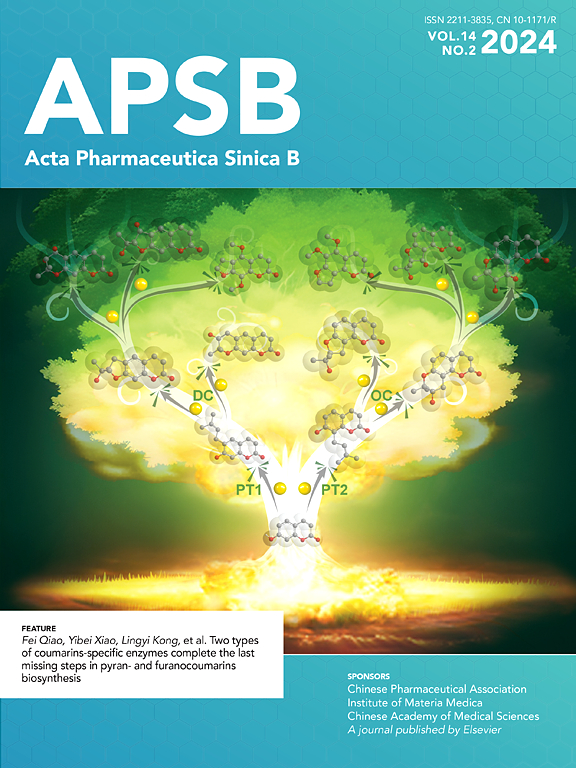Design, molecular characterization and therapeutic investigation of a novel CCR8 peptide antagonist that attenuates acute liver injury by inhibiting infiltration and activation of macrophages
IF 14.7
1区 医学
Q1 PHARMACOLOGY & PHARMACY
引用次数: 0
Abstract
During liver injury, intrahepatic macrophage compartment is augmented by circulating monocytes that infiltrate the liver driven by C–C motif chemokine ligand/C–C motif chemokine receptor (CCL/CCR) axis including CCL1‒CCR8 axis, thereby contributing to liver inflammation. Numerous small molecular receptor antagonists, including R243, have been developed for targeting CCR8; however, these agents face challenges in clinical translation, potentially attributed to their poor pharmacokinetic profiles, lack of target specificity, and potential adverse effects. In this study, we designed four CCR8 antagonizing peptides (AP8i-AP8iv) and performed molecular characterization in silico and therapeutic investigation in vitro and in vivo. Based on in silico docking, molecular dynamic simulation using homology build model and in-vitro (competitive) binding studies, AP8ii (YEWRFYHG) evidenced highly favorable and selective interactions at the CCR8-active site. AP8ii inhibited CCL1-driven chemotaxis and LPS/IFNγ-induced pro-inflammatory activation of monocytes-macrophages in vitro. In a CCl4-induced acute liver injury mouse model, AP8ii treatment decreased intrahepatic infiltration of circulating monocytes. Moreover, AP8ii reduced liver inflammation, as indicated by decreased F4/80, IL6 and iNOS expression, diminished ALT levels, and attenuated fibrosis, as indicated by reduced collagen-I expression. In conclusion, we report a novel CCR8-antagonizing peptide that inhibited CCL1-driven intrahepatic monocytes infiltration and differentiation into pro-inflammatory phenotype, consequently ameliorating liver inflammation and fibrogenesis in an acute liver injury mouse model.

一种新型CCR8肽拮抗剂的设计、分子表征和治疗研究,该拮抗剂通过抑制巨噬细胞的浸润和激活来减轻急性肝损伤
在肝损伤期间,肝内巨噬细胞室被循环单核细胞增强,这些单核细胞在C-C基序趋化因子配体/ C-C基序趋化因子受体(CCL/CCR)轴(包括CCL1-CCR8轴)的驱动下浸润肝脏,从而促进肝脏炎症。许多小分子受体拮抗剂,包括R243,已被开发用于靶向CCR8;然而,这些药物在临床转化中面临挑战,这可能归因于它们较差的药代动力学特征、缺乏目标特异性和潜在的不良反应。在这项研究中,我们设计了4种CCR8拮抗肽(AP8i-AP8iv),并进行了硅分子表征和体外和体内治疗研究。基于硅对接、同源构建模型的分子动力学模拟和体外(竞争性)结合研究,AP8ii (YEWRFYHG)在ccr8活性位点证明了高度有利和选择性的相互作用。AP8ii在体外抑制ccl1驱动的趋化和LPS/ ifn γ诱导的单核-巨噬细胞促炎激活。在ccl4诱导的急性肝损伤小鼠模型中,AP8ii治疗降低了循环单核细胞的肝内浸润。此外,AP8ii减轻了肝脏炎症,F4/80、IL6和iNOS表达降低,ALT水平降低,胶原- i表达降低,纤维化减轻。总之,我们报道了一种新的ccr8拮抗肽,可以抑制ccl1驱动的肝内单核细胞浸润和向促炎表型的分化,从而改善急性肝损伤小鼠模型中的肝脏炎症和纤维化。
本文章由计算机程序翻译,如有差异,请以英文原文为准。
求助全文
约1分钟内获得全文
求助全文
来源期刊

Acta Pharmaceutica Sinica. B
Pharmacology, Toxicology and Pharmaceutics-General Pharmacology, Toxicology and Pharmaceutics
CiteScore
22.40
自引率
5.50%
发文量
1051
审稿时长
19 weeks
期刊介绍:
The Journal of the Institute of Materia Medica, Chinese Academy of Medical Sciences, and the Chinese Pharmaceutical Association oversees the peer review process for Acta Pharmaceutica Sinica. B (APSB).
Published monthly in English, APSB is dedicated to disseminating significant original research articles, rapid communications, and high-quality reviews that highlight recent advances across various pharmaceutical sciences domains. These encompass pharmacology, pharmaceutics, medicinal chemistry, natural products, pharmacognosy, pharmaceutical analysis, and pharmacokinetics.
A part of the Acta Pharmaceutica Sinica series, established in 1953 and indexed in prominent databases like Chemical Abstracts, Index Medicus, SciFinder Scholar, Biological Abstracts, International Pharmaceutical Abstracts, Cambridge Scientific Abstracts, and Current Bibliography on Science and Technology, APSB is sponsored by the Institute of Materia Medica, Chinese Academy of Medical Sciences, and the Chinese Pharmaceutical Association. Its production and hosting are facilitated by Elsevier B.V. This collaborative effort ensures APSB's commitment to delivering valuable contributions to the pharmaceutical sciences community.
 求助内容:
求助内容: 应助结果提醒方式:
应助结果提醒方式:


